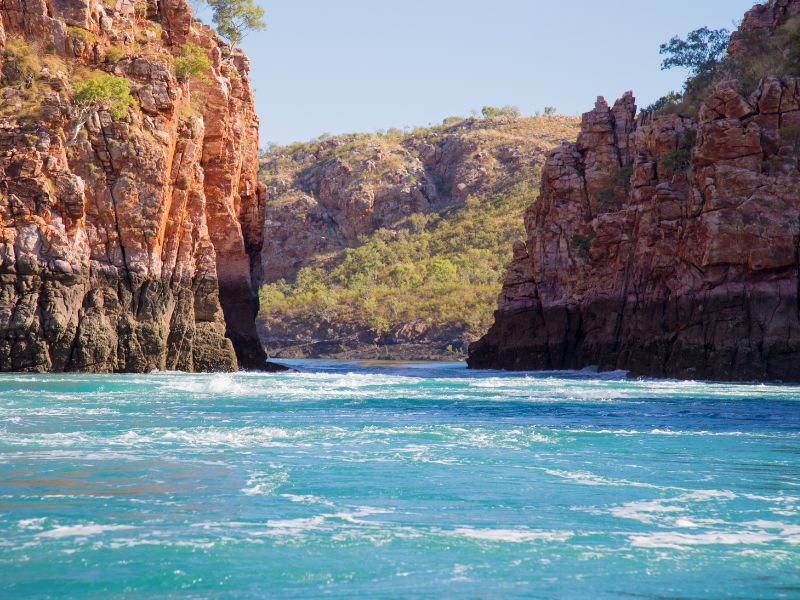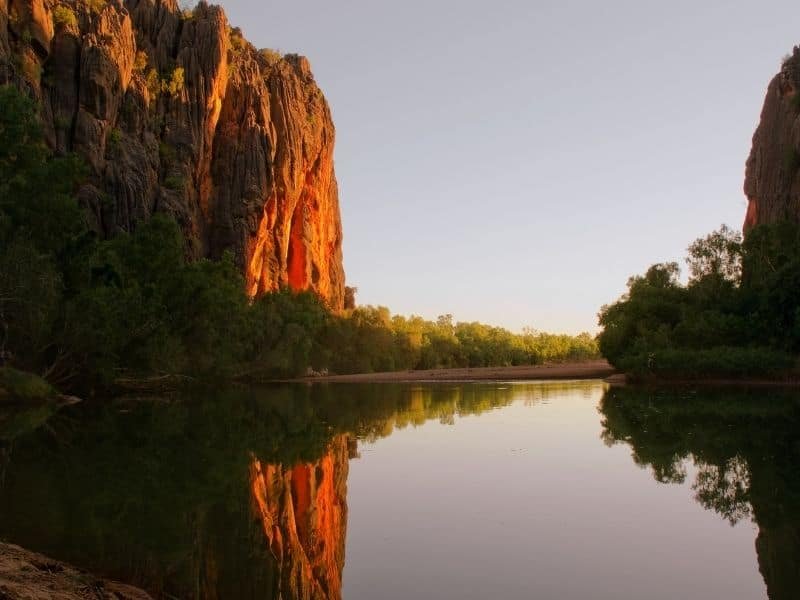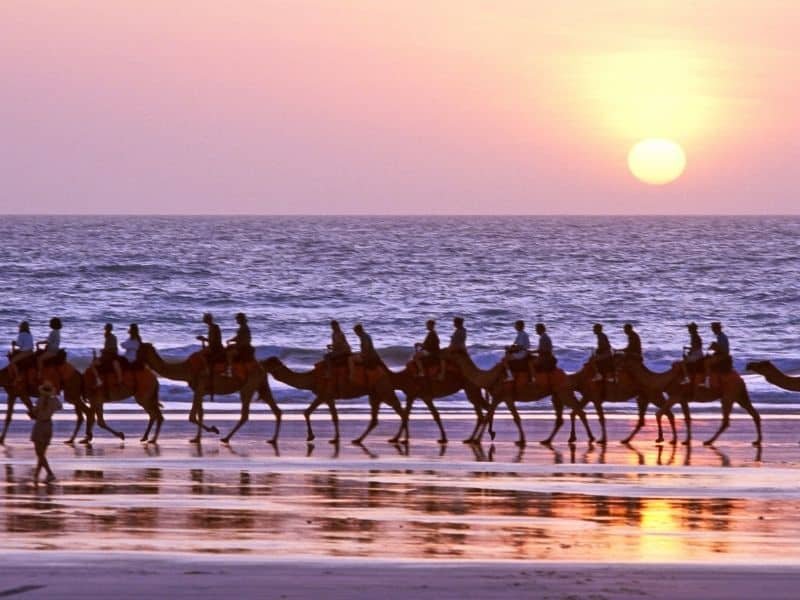Are you planning a trip to Western Australia? If so, you won’t want to miss the Kimberley region.
This vast and rugged area is located in the northern part of the state and is home to some of Australia’s most stunning natural scenery.
#1 – Explore the Bungle Bungle Range

The Bungle Bungle Range is one of the most iconic landmarks in the Kimberley region. They are a series of sandstone domes eroded over millions of years to create a unique landscape unlike anywhere else.
This range of sandstone domes is located in Purnululu National Park and is a UNESCO World Heritage site.
You can explore the Bungle Bungle Range on foot by hiking one of the many trails in the park. Or you can even take a scenic helicopter ride for a bird’s-eye view of the area. The Cathedral Gorge and Echidna Chasm walk are two of the most popular.
Tip: Bring plenty of water and sunscreen, as the Kimberley can get hot.
#2 – Take a Scenic Flight over the Horizontal Falls

The Horizontal Falls are one of the unique natural wonders in the world. This natural wonder is created by a narrow gap between two cliffs, which causes the water to rush through at an incredible speed. These tidal waterfalls are located in Talbot Bay and can only be accessed by boat or seaplane.
Taking a scenic flight over the falls is a once-in-a-lifetime experience you won’t miss. You’ll get a bird’s-eye view of the falls and the surrounding coastline.
Tip: If you’re prone to motion sickness, take medication before your flight.
#3 – Visit the Gibb River Road

The Gibb River Road is a 660-kilometer-long dirt track that runs through the heart of the Kimberley. Driving the Gibb River Road is an adventure, as you’ll pass through some of Australia’s most remote and rugged terrains.
Along the way, you’ll pass through stunning gorges, waterfalls, and rock formations and have the chance to see some of the region’s unique wildlife, such as the elusive Gouldian Finch.
Some Gibb River Road highlights include Windjana, Bell, and Manning Gorge.
Tip: Check road conditions before setting out on Gibb River Road, as it can be closed during the wet season.
#4 – Explore Windjana Gorge National Park

Windjana Gorge National Park is a stunning area of rugged cliffs and freshwater pools and is home to a diverse range of wildlife, including freshwater crocodiles, wallabies, and birds.
You can take a guided tour to learn more about the geology and ecology of the area or wander along the walking trails and soak up the natural beauty.
Tips: The trails in Windjana Gorge National Park can be rocky and uneven, so wearing sturdy shoes with good grip is important.
#5 – Cruise the Kimberley Coast

The Kimberley coast is one of the world’s most remote and untouched coastlines. A cruise along the coast is a great way to see the region’s stunning scenery and wildlife.
You’ll have the chance to see whales, dolphins, crocodiles, and other marine life and visit remote beaches and islands.
Tip: Bring a camera and binoculars to capture the wildlife and scenery.
#6 – Visit the Boab Prison Tree

The Boab Prison Tree is a unique landmark in the Kimberley. This giant baobab tree is believed to be over 1,500 years old and was used as a holding cell for Aboriginal prisoners during the 1890s.
Today, the tree is a popular tourist attraction and a reminder of the region’s colonial past. You can visit the tree and learn more about its history and see some of the ancient rock art found in the area.
Tip: Be sure to respect the cultural significance of the Boab Prison Tree and its history.
#7 – Take a Camel Ride on Cable Beach

Cable Beach is one of the most iconic beaches in Australia, with its white sands and crystal-clear waters.
One of the best ways to experience the beauty of Cable Beach is on the back of a camel. Camel rides are available at sunrise or sunset and provide a unique perspective of the beach and the surrounding area.
Tip: For watching the sunset, arrive early to get a good spot on the beach, as it can get crowded during peak season.
#8 – Explore the Mitchell Plateau

The Mitchell Plateau is a remote and rugged area in the Kimberley home to some of the region’s most stunning natural scenery. The plateau is accessible by 4WD only and is home to Mitchell Falls, one of Australia’s most spectacular waterfalls.
The Mitchell Falls are a series of four waterfalls considered one of the most spectacular natural attractions in the Kimberley Region. You can hike to the falls and dip in the refreshing pools or take a scenic helicopter flight to see the falls from above.
Tip: Be sure to bring plenty of food and water, as no facilities are on the Mitchell Plateau.
#9 – Visit Lake Argyle

Lake Argyle is the largest man-made lake in Australia and a popular spot for fishing, boating, and swimming.
A lookout at the top of a nearby hill offers stunning views of Lake Argyle and the surrounding landscape. The hike to the lookout can be challenging, but the views are worth it.
You can also take a sunset cruise to see the stunning colors of the sky reflected in the water or go on a guided tour to learn more about the history and ecology of the area.
Tip: Bring plenty of water and sunscreen to stay comfortable during your visit.
#10 – See the Staircase to the Moon
The Staircase to the Moon is a natural phenomenon that occurs when a full moon rises over the exposed tidal flats of Roebuck Bay. The moon’s reflection on the mudflats creates an optical illusion that looks like a staircase leading up to the moon, hence the name.
The staircase to the moon can be seen from several locations along the coast, including Town Beach, Broome, Roebuck Bay, and Cable Beach. The phenomenon occurs 2-3 days a month between March and October, with the best viewing times being at sunset and just after the moonrise.
Several events and festivals are held in Broome to celebrate the staircase to the moon, including markets, food stalls, and live music performances. Many locals and tourists gather on the beaches to watch the phenomenon and take photos.
Tips: Check the dates and times and plan your trip accordingly. It’s also a good idea to bring a camera and a tripod to capture the stunning views.
Tips for Visiting the Kimberley Region
- The Kimberley Region is vast and remote, so it’s essential to plan your trip carefully and be prepared for long distances and limited services.
- The best time to visit Kimberley is during the dry season, which runs from April to October. The wet season can bring heavy rainfall and flooding, making many areas inaccessible.
- It’s essential to respect the area’s cultural heritage and seek permission before visiting sacred sites or performing any activities that may be considered disrespectful.
- The Kimberley is home to diverse wildlife, including crocodiles and snakes, so taking appropriate precautions and being aware of your surroundings is essential.
- Many of the attractions in the Kimberley require a 4WD vehicle, so ensure you have the appropriate equipment and experience before setting out.
FAQs
When is the best time to visit the Kimberley region?
The best time to visit Kimberley is during the dry season, which runs from April to October. The weather is mild and dry during this time, making it ideal for outdoor activities.
Is it safe to swim in Kimberley’s natural pools and waterfalls?
Swimming in Kimberley’s natural pools and waterfalls can be safe, but being aware of the risks is essential. Some areas may be home to crocodiles or have strong currents, so following any local warning signs or advice is essential.
Do I need a 4WD to explore Kimberley?
Having a 4WD can make it easier to explore the Kimberley, as many areas are only accessible by dirt tracks. However, it’s possible to see many of the region’s highlights without a 4WD by taking guided tours or hiring a car.











